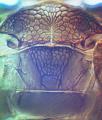Dinurothrips hookeri
Recognition data
Distinguishing features
Both sexes fully winged. Body dark brown to dark brown; tibiae yellow to yellowish brown; antennal segments III–V yellow, remaining segments brown; fore wing brown with sub-basal paler area. Head strongly reticulate, ocellar region elevated, cheeks convex and sharply constricted behind eyes. Antennae 8-segmented, segment III with one simple sensorium, IV with two simple sensoria, VIII slender and at least 3 times as long as VII. Pronotum strongly reticulate, with no long setae. Mesonotum reticulate, sharply incut at posterior margin. Metanotum with reticulate area almost triangular, median setae arise on posterior half of sclerite, campaniform sensilla present. Tarsi 1-segmented. Fore wing with pointed apex curving forwards slightly; costa with setae shorter than cilia, setae on first and second veins short; posteromarginal cilia wavy. Abdominal tergites strongly reticulate including median area; median setae short and far apart; II with anterior margin constricted; VIII with craspedum finely toothed laterally; tergite X long, about twice as long as IX, with complete median division. Sternites with three pairs of small marginal setae; craspedum broad and entire.
Male similar to female; tergite IX medially with pair of thorn-like setae; sternites III–VII each with broadly U-shaped pore plate.
Related and similar species
Only two species are placed in Dinurothrips. The second, D. vezenyii from Argentina and Brazil, is structurally similar but has the tarsi 2-segmented, the mesonotum divided longitudinally, the tibiae brown, and micropterous adults are sometimes produced.
Taxonomic data
Current valid name
Dinurothrips hookeri Hood
Original name and synonyms
- Dinurothrips hookeri Hood, 1913: 151
Family placement
Thripidae, Panchaetothripinae
Biological data
Life history
Larvae and adults feeding on leaves; pupae also on leaves.
Host plants
Recorded from the leaves of a wide range of plants, including tomatoes, sweet potatoes, and various garden plants (Wilson, 1975). In January 2012 this thrips was found damaging banana leaves in Guam.
Tospoviruses vectored
None
Crop damage
Leaves become mottled due to feeding damage.
Distribution data
Area of origin
South America.
Distribution
Not known from California, but widespread in Caribbean countries, recorded from Florida and Brazil, and in 2012 from Guam.







